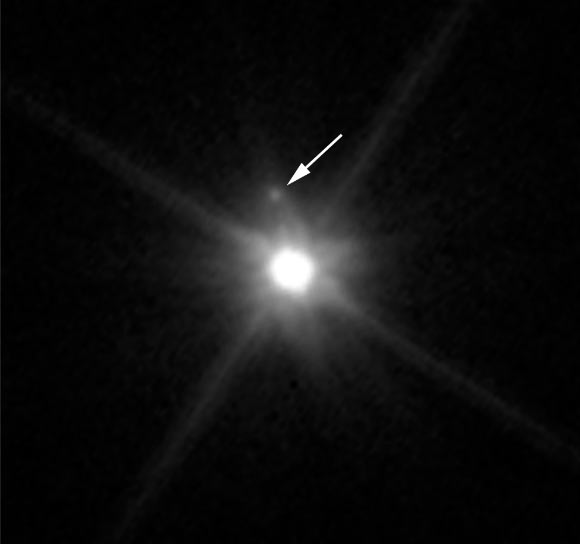Using the NASA/ESA Hubble Space Telescope, astronomers have discovered a tiny, dark moon orbiting the dwarf planet Makemake, one of several dwarf planets that reside in the frigid outer realm of the Solar System called the Kuiper Belt. The discovery was announced this week in the Minor Planet Electronic Circular (MPEC) newsletter.

This artist’s concept shows Makemake and its moon, MK 2. Image credit: NASA / ESA / Alex Parker, Southwest Research Institute.
Makemake, also known as 2005 FY9 and (136472), was discovered in 2005 by a team of scientists from the California Institute of Technology led by Mike Brown.
This dwarf planet is located in a region beyond Neptune that is populated with small Solar System bodies.
It is about is 870 miles wide, just slightly smaller and dimmer than Pluto. It is reddish in color and researchers believe the surface is covered by a layer of frozen methane.
Makemake’s newfound moon, designated S/2015 (136472) 1 and nicknamed MK 2, is around 100 miles across and is more than 1,300 times fainter than the dwarf planet. It was seen approximately 13,000 miles from Makemake.
The observations were made in April 2015 with Hubble’s Wide Field Camera 3.

This Hubble image reveals the first moon ever discovered around the dwarf planet Makemake. Image credit: NASA / ESA / Alex Parker & Marc Buie, Southwest Research Institute.
“We collected deep imagery of Makemake with the Wide Field Camera 3 on the Hubble Space Telescope (HST) in the broad F350LP filter over two epochs in April 2015,” said Dr. Alex Parker from the Southwest Research Institute and his colleagues – Dr. Keith Noll from NASA, Dr. Marc Buie from the Southwest Research Institute, and Dr. Will Grundy of Lowell Observatory.
The scientists used the same technique to observe MK 2 as they did for finding the small moons of Pluto in 2005, 2011, and 2012. Several previous searches around Makemake had turned up empty.
“Our preliminary estimates show that the moon’s orbit seems to be edge-on, and that means that often when you look at the system you are going to miss the moon because it gets lost in the bright glare of Makemake,” Dr. Parker said.
“We find that the MK 2’s likely semi-major axis is larger than 21,000 km and its orbital period is longer than 12 days,” the astronomers said.
They will need more Hubble observations to make accurate measurements to determine if the moon’s orbit is elliptical or circular.
Determining the shape of the moon’s orbit will help settle the question of its origin.
A tight circular orbit means that MK 2 is probably the product of a collision between Makemake and another Kuiper Belt object. If the moon is in a wide, elongated orbit, it is more likely to be a captured object from the Kuiper Belt. Either event would have likely occurred several billion years ago, when the Solar System was young.
_____
A.H. Parker et al. 2016. S/2015 (136472) 1. Minor Planet Electronic Circular, 2016-H46







